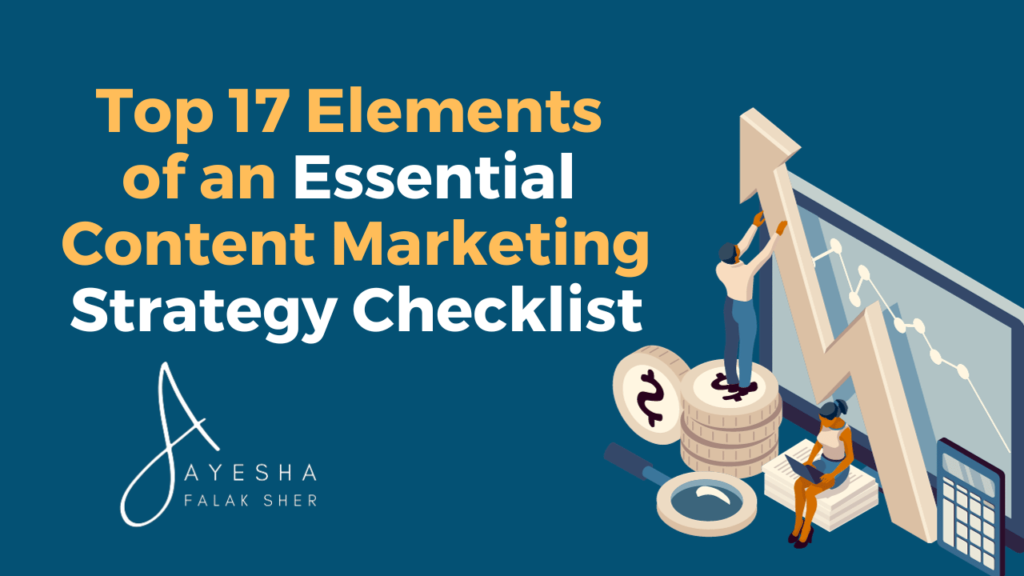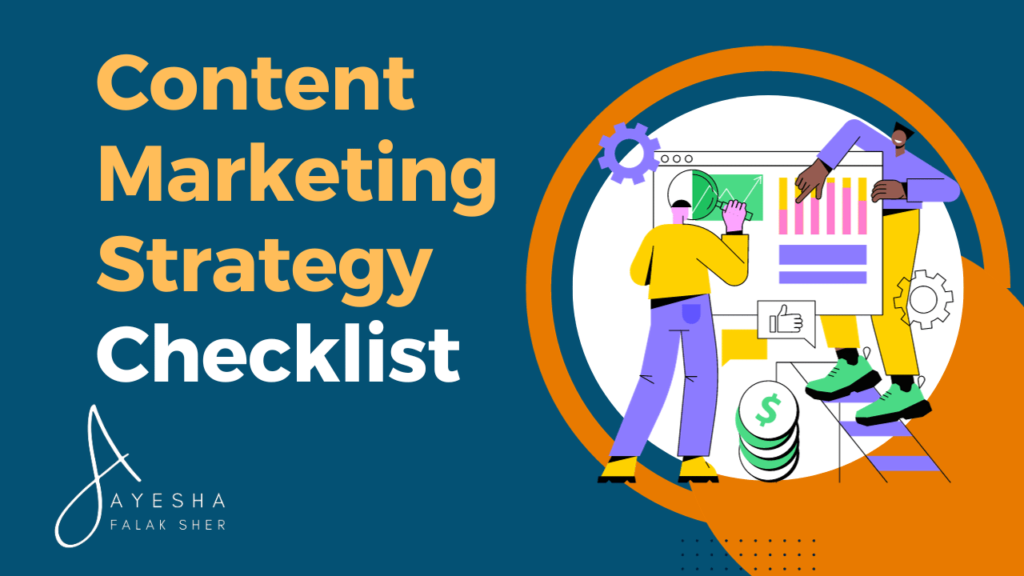As businesses grapple with the ever-changing dynamics of consumer behavior, a robust content marketing strategy checklist remains the bedrock of a compelling online presence.
As the digital world evolves, businesses must stay updated with effective strategies to connect with their audience.
Content marketing remains vital, allowing companies to communicate their brand’s message, products, and values.
With 2024 on the horizon, adapting and refining one’s content approach becomes increasingly essential.
This article presents a straightforward content marketing strategy checklist, ensuring businesses remain at the forefront of their industry’s content marketing trends.
In so doing, organizations can continue to resonate with their target demographics, fostering growth and brand loyalty in a dynamic digital age.
Table of Contents
ToggleWhat Is Content Marketing Strategy Checklist?
A Content Marketing Strategy Checklist is a comprehensive list of steps and guidelines that businesses and marketers follow to plan, create, and manage their content marketing efforts effectively.
It serves as a roadmap to ensure that content aligns with business goals, resonates with the target audience, and achieves desired results.
The checklist typically includes tasks such as audience research, keyword analysis, content creation, promotion, and performance measurement, among others, to create a well-rounded content marketing strategy.
Top 17 Elements of an Essential Content Marketing Strategy Checklist
These content marketing strategies are like basic principles that guide your content creation journey.
Here is the top content marketing strategy checklist that you should follow.
1. Content Marketing Strategy Checklist: Understand Your Target Audience

While talking about the first step of the content marketing strategy checklist, connecting with the right people matters.
Imagine talking about the newest video game to someone who doesn’t play it – there might be better fits.
That’s why it’s crucial to know who you’re talking to when creating content.
It’s 2023, and just like how we enjoy personal touches in the gifts we receive, online content is becoming super personalized.
Imagine opening a book and finding it written just for you.
That’s the direction the content is taking.
Brands are now diving deep, focusing on not just broad groups but tiny segments.
So, it’s not just ‘vegan food lovers’ but ‘vegan food lovers who enjoy quick recipes and live in urban areas.’
This precision makes the content feel like speaking directly to the reader.
Read my latest post about Content Marketing Strategy.
Why It Matters?
Everyone has their interests and preferences.
By understanding the audience’s likes, dislikes, habits, and needs, it’s like having a conversation with a friend.
You’ll discuss topics they care about in a natural and relatable way.
How to Know Your Audience:
Here’s how to dig deeper into this essential element:
1. Identify Personas:
Start by creating detailed buyer personas.
These are semi-fictional representations of your ideal customers.
Consider their demographics, psychographics, and behaviors.
For our example, let’s delve into “Eco-conscious Emma” a bit more:
- Demographics: Emma is a 35-year-old woman, married, with two children, living in an urban setting.
- Psychographics: She’s deeply concerned about the environment and values sustainability. Emma actively seeks out eco-friendly products and supports brands with ethical practices.
- Behavior: Emma regularly reads blogs and follows social media accounts focused on sustainable living. She prefers to make informed choices and is willing to pay a premium for eco-friendly skincare products.
2. Empathize with Their Needs:
Put yourself in Emma’s shoes. What are her pain points, challenges, and aspirations regarding skincare?
You realize that Emma worries about the long-term effects of chemicals in her skincare products on her family’s health and the environment.
3. Tailor Content to Address Needs:
Knowing Emma’s concerns, you can tailor your content to provide solutions.
You might create content about the harmful chemicals commonly found in skincare products, tips for choosing eco-friendly skincare, or testimonials from customers like Emma who have benefited from your products.
Example 1 – Vegan Restaurant:
- Situation: The restaurant decides to create content.
- Think of a new vegan restaurant in town. They serve delicious plant-based meals that are both healthy and eco-friendly. Who would be the best folks to tell this to? Those who are already inclined towards veganism or are conscious about the environment.
- Without Targeting: They talk about how plants are grown, the science of veganism, and maybe throw some complicated recipes.
- With Targeting: Knowing their audience is eco-conscious millennials, they post easy vegan recipes, share stories of local farmers who supply their fresh produce, and perhaps even showcase a day in the life of a vegan. They might also share tips on sustainable living, touching on subjects their audience deeply cares about.
Example 2 – Local Gym:
Consider a local gym trying to attract members.
They know that most folks in the community have never set foot in a gym and are a bit nervous about starting.
- Situation: The gym wants to create content to ease these worries.
- Without Targeting: They post high-intensity workout videos, discuss the science behind muscle growth, and use jargon that beginners might find intimidating.
- With Targeting: Realizing they’re speaking to beginners, they share stories of members who started their fitness journey just like them. They introduce friendly trainers, offer simple home workouts, and guide on taking those first steps in the gym.
2. Content Marketing Strategy Checklist: Keyword Research
Keyword research is like a compass guiding you to the topics and phrases that resonate with your audience.
Let’s dive deeper into this step:
Explore Relevant Keywords:
Use tools like Google Keyword Planner, SEMrush, or Ahrefsto to discover keywords that align with your content.
For our example, consider the “natural skincare routine”:
- Check the search volume: Determine how often people search for this keyword. You find that “natural skincare routine” has a substantial monthly search volume, indicating it’s a popular topic.
- Analyze Competition: Assess the keyword’s competition. If it’s highly competitive, it might be challenging to rank for. However, long-tail variations like “simple natural skincare routine for busy moms” could be more attainable.
- Understand User Intent: Put yourself in the searcher’s shoes. What are they looking to find when they search for a “natural skincare routine”? Users might be seeking step-by-step guides, product recommendations, or DIY tips.
Create Content Around Keywords:
Armed with keyword insights, you can craft content that aligns with what your audience is searching for.
For instance, create a comprehensive guide to a natural skincare routine, including product recommendations from your brand.
Organically Incorporate Keywords:
When creating content, remember that keywords should be integrated naturally.
Avoid stuffing your content with keywords; ensure they fit seamlessly into the narrative.
Write for humans first and search engines second.
By expanding upon these aspects, you can establish a deeper connection with your audience and refine your content strategy to align with their needs and preferences.
Keyword research becomes a powerful tool for guiding your content creation process, ensuring you address topics and questions that matter most to your audience.
3. Content Marketing Strategy Checklist: Set Clear Goals
Every successful marketing strategy is rooted in clarity.
One might liken it to a ship’s compass, guiding it safely through tumultuous seas toward its intended destination.
Without well-defined objectives, content can easily veer off course, failing to resonate with its target audience or meet desired outcomes.
It’s not just theoretical; the numbers affirm the importance of setting objectives.
Surveys and studies have consistently demonstrated that businesses of all sizes and in various sectors use content to build brand awareness, inform consumers, and increase profits.
Businesses quickly embraced this form of marketing and dedicated ever-increasing funds to it, especially during the coronavirus (COVID-19) pandemic, which witnessed a significant spike in consumer demand for quality and appealing internet content.
According to data, the content market industry generated 63 billion dollars in revenue in 2022, and the current projections indicate that it will generate 107 billion dollars by 2026.
Importance of Clear Objectives in Content Marketing
Objectives play multiple pivotal roles:
- Guiding Content Creation: By knowing the end goal, one can tailor content to fit the narrative and journey that directs the audience towards that goal.
- Measurement & Analysis: Objectives provide a benchmark against which the success of content can be gauged, allowing for iterations and improvements.
- Resource Allocation: With clear objectives, businesses can better decide where to invest time, money, and human resources for maximum ROI.
Identify Specific Objectives:
Your goals should be specific, measurable, attainable, relevant, and time-bound (SMART).
In our previous example:
- Specific: Increase website traffic by 30% and boost sales by 20%.
- Measurable: You can use Google Analytics to track website traffic and sales.
- Attainable: This goal is realistic, given your current resources and market conditions.
- Relevant: It directly relates to your business’s growth and success.
- Time-bound: You set a timeframe of one year for achieving these goals.
Segment Goals:
Consider segmenting your goals for different aspects of your content marketing.
For instance, you might have separate goals for blog, video, and social media content.
Establish Key Performance Indicators (KPIs):
Determine the specific metrics you’ll use to measure success.
For website traffic, KPIs include page views, unique visitors, and bounce rates.
For sales, track conversion rates, revenue, and average order value.
Example: A Skincare Brand’s Strategy
Consider a hypothetical skincare brand, ‘DermSolutions.’
Their objective isn’t merely to sell products but to position themselves as educators in skin health.
How does this objective shape their content marketing?
- Content Creation: Rather than just showcasing their products, they produce articles, videos, and infographics about skin types, the science behind skin aging, the importance of sun protection, and more.
- Engagement: They emphasize their educator role by hosting webinars or live Q&A sessions on skin health, further consolidating their position.
- Measurement: Success isn’t just measured by product sales. Engagement rates on educational content, sign-ups for webinars, and feedback on informational materials become equally crucial metrics.
Challenges in Setting Clear Objectives
While the importance of clear objectives is undeniable, setting them can be challenging. Common challenges include:
- Broad Objectives: Goals like “increase brand awareness” are too vague. Instead, “increase website traffic by 20% in Q2” offers clarity and measurability.
- Misaligned Objectives: Objectives must align with broader business goals. For instance, if a business’s goal is customer retention, then content should focus on value addition for existing customers rather than broad-based outreach.
- Static Objectives: The digital space evolves rapidly. What was relevant a year ago might not be today. Regularly revisiting and refining objectives ensures they remain aligned with the current landscape.
4. Content Marketing Strategy Checklist: Audit Existing Content
Imagine you have a garden.
Just like you need to look after your garden regularly, it’s important to take a closer look at the content you already have on your website occasionally.
This is called an “audit,” it helps you figure out what’s still good, what’s not, and what might need a little fixing.
Why It’s Important:
Think of it this way:
If you have a toy collection and never check to see if all the toys are still in good condition, some might get broken or old without knowing.
The same thing can happen to the stuff on your website.
Some might not be helpful anymore, but you will only know if you check.
Example:
Let’s say you run a website that talks about animals.
You have many articles about animals like lions, tigers, and bears.
These articles are like different toys in your collection.
Over time, some of these articles might not be as good as they used to be.
Maybe they have old information, or people need to be reading them.
It’s like having old, dusty toys that no one plays with.
So, you decide to do a “content audit” to see what’s going on:
Step 1: Make a List
Just like you’d make a list of all your toys, you make a list of all the articles on your website.
Step 2: Check Everything
Now, you start looking at each article:
- Is it Still Useful? You ask yourself if the article is still helpful to people who visit your website. If not, it’s like having a broken toy that can’t be used anymore.
- How well is it doing? You check if people are still reading the article. Are they clicking on it and spending time reading it? If not, it’s like having a toy no one wants to play with.
- Is it Well-Made? You also look at the quality of the article. Is it well-written, or does it have mistakes? It’s like making sure your toys are clean and in good shape.
- Does it match? Consider whether the article still fits with what your website is all about. Does it belong there? It’s like making sure your toys belong in your collection.
Step 3: Decide What to Do
After checking everything, you decide what to do with each article:
- Keep: If it’s still helpful and people like it, keep it as it is.
- Fix: If it’s good but needs some changes, you fix it so it’s better.
- Change: Some articles can be turned into something else, like making a video from an article.
- Remove: If it’s old and not helpful, you might take it off your website, like getting rid of a broken toy.
Step 4: Make Changes
Then, you do what you decide. You make changes to the articles based on your decisions.
Step 5: Keep an Eye
After making changes, you keep an eye on how things are going.
You see if the changes make a difference.
It’s like checking if fixing your toys or cleaning them up makes them more fun to play with.
Ultimately, doing a content audit helps you keep your website fresh and useful, just like taking care of your toys so they stay fun to play with.
Map Out Different Types of Content
In content marketing, you must diversify the types of content you create to engage your audience effectively.
Not everyone likes the same ice cream flavor.
Similarly, different people prefer different types of content.
Some enjoy reading long articles, while others might love a quick infographic or a chatty podcast.
Offering a mix ensures you cater to everyone.
Here, we’ll explore various content types and provide examples to help you understand their purpose and use:
- Articles: Articles are written content that provides in-depth information or insights on a particular topic. They are like informative essays. For instance, you could write an article about “10 Effective Ways to Save Money.”
- Videos are visual content that can educate, entertain, or inform. They are like short movies. A video could be a tutorial on “How to Cook a Delicious Pasta Dish.”
- Images and Infographics: Images and infographics are visual representations of information. They are like visual summaries. An infographic could illustrate “The Benefits of Regular Exercise.”
- Podcasts: Podcasts are audio recordings people can listen to online or download. They are like radio shows. You could create a podcast discussing “The History of Jazz Music.”
- Quizzes and Polls: Quizzes are interactive content where users answer questions to test their knowledge. Polls allow users to vote on a specific question. For example, you could have a quiz about “Famous Historical Figures” or a poll asking, “What’s Your Favorite Season?”
- How-To Guides: How-to guides are instructional documents that provide step-by-step directions on accomplishing a task. They are like instruction manuals. You could create a how-to guide on “Building a Garden Shed.”
- Case Studies: Case studies present real-life examples and outcomes, often showcasing the success of a product or service. They are like success stories. You might write a case study on “How Company X Increased Sales by 50%.”
- Interviews involve conversations with individuals, often experts or notable figures, to gather insights or opinions. They are like talk shows. An example could be an interview with a renowned scientist discussing “Climate Change Solutions.”
- Product Reviews: Product reviews offer assessments of products or services based on personal experiences. They are like customer feedback. You could write a product review for the latest smartphone model.
- Lists: Lists straightforwardly organize information, making it easy for readers to digest. They are like checklists. An example might be “5 Essential Tips for Healthy Living.”
Tailoring your content to these preferences enhances your ability to effectively engage and connect with your target audience.
Read Now:
5. Content Marketing Strategy Checklist: Choose the Right Distribution Channels
Selecting the proper places to share your content is like choosing the right path to walk on.
You want to ensure you reach the people interested in your words.
Why It’s Important:
Think about it as deciding which road to take to get to your friend’s house.
If you pick the wrong one, you might be far from where you want to be.
Similarly, if you share your content on the wrong platforms, you may not reach your audience.
How to Do It:
Identify where your audience hangs out online.
If your audience prefers reading, sharing your content on a blog or social media might work.
If they like videos, consider YouTube or other video-sharing sites.
Pick the channels that match your audience’s preferences.
6. Content Marketing Strategy Checklist: Implement SEO Best Practices
Using SEO (Search Engine Optimization) is like putting signs on the road to help people find their way to your content.
It ensures that your content is easily discoverable when people search online.
Why It’s Important:
Imagine you have a store, but there’s no sign outside. Nobody would know you exist. SEO is like that sign. It helps people find your content when they search for related topics.
How to Do It:
- Use relevant keywords: Consider the words people might type into a search engine to find your content. Use those words naturally in your content.
- Write good titles and descriptions: Your titles and descriptions should give a clear idea of your content.
- Make your website easy to navigate: Just like a well-organized store is easier to shop in, a well-structured website is easier for search engines to understand.
7. Content Marketing Strategy Checklist: Quality over Quantity
In content marketing, it’s better to focus on making your content good instead of making much of it.
It’s like baking a delicious cake.
Instead of baking many small, mediocre cakes, you bake one delicious cake everyone enjoys.
When you prioritize quality, your audience will more likely appreciate and engage with your content.
They’ll keep returning for more because they trust your creation will be worthwhile.
Prioritizing quality ensures that your content stands out in a crowded digital landscape:
Invest in Research and Expertise:
Invest time in thorough research to provide accurate and valuable information.
If you need to become an expert in a topic, consult industry professionals or conduct interviews to gather authoritative insights.
Craft Engaging Headlines:
Your headlines should be compelling and concise.
A great headline piques curiosity and encourages readers to click and explore further.
Optimize Visual Elements:
Visuals matter.
High-quality images, graphics, and videos enhance the visual appeal of your content.
Ensure they’re relevant to the topic and aid in understanding.
8. Content Marketing Strategy Checklist: Promote Your Content
Creating content is only half the job.
You also need to tell people about it.
Think of it like throwing a party.
Even if you have the best party in town, no one will show up if you don’t invite anyone.
Promoting your content means sharing it on social media, emailing it to your subscribers, and using other methods to get the word out.
This way, more people will see and enjoy what you’ve created.
Creating content is only half the battle.
Effective promotion is essential for visibility:
Social Media Promotion:
Share your content across your social media channels.
Craft engaging posts that highlight key points and encourage sharing.
Consider using paid social advertising to boost reach.
Email Marketing:
Utilize your email list to notify subscribers about new content.
Craft personalized and enticing subject lines to increase open rates.
Collaborations and Guest Posting:
Partner with influencers or related businesses for co-promotions.
Guest posting on reputable industry websites can also expand your reach and credibility.
9. Content Marketing Strategy Checklist: Adapt to Changes
The digital world is always changing.
Think of it as the weather – sometimes sunny and sometimes rainy. You need to adapt to these changes.
For instance, search engines and social media platforms change their rules and algorithms.
You must stay updated and adjust your content strategy accordingly.
Just like you carry an umbrella when it’s raining, you adapt your content when the online landscape changes.
The digital landscape is in constant flux.
Stay adaptable and:
Monitor Industry Trends:
Monitor industry news, emerging technologies, and changing consumer behaviors.
Subscribe to newsletters, join industry forums, and attend webinars or conferences to stay informed.
Algorithm Updates:
Search engines and social media algorithms change frequently.
Adapt your SEO and content distribution strategies accordingly.
10. Content Marketing Strategy Checklist: Collaborate and Network
In content marketing, you don’t have to do everything alone.
It’s like gardening – you can’t grow all the plants alone.
Sometimes, you need help from others.
Collaborating means working with other people or businesses.
You can co-create content, share each other’s work, or even guest post on each other’s websites.
This way, you reach new audiences and strengthen your network.
Networking can open doors to valuable partnerships:
Identify Potential Partners:
Identify influencers, complementary businesses, or thought leaders in your niche.
Reach out with collaboration proposals that benefit both parties.
Joint Content Creation:
Collaborate on content creation.
Co-author articles, co-host webinars, or create videos together.
These joint efforts can tap into each other’s audience.
11. Content Marketing Strategy Checklist: Invest in Education
Learning is like planting seeds in your content garden.
The more you know, the better your content becomes.
It’s like reading a recipe book to become a better cook.
Investing in education means taking courses, attending webinars, or reading books and articles related to content marketing.
This knowledge helps you create more valuable content and stay ahead of the game.
Continuous learning keeps your strategy fresh and effective:
Online Courses and Workshops:
Explore online courses, webinars, and workshops on content marketing, SEO, and digital marketing trends.
Platforms like Coursera, LinkedIn Learning, and HubSpot offer valuable resources.
Internal Training:
Invest in training for your content marketing team.
This can include workshops, certifications, or subscriptions to industry publications. Knowledgeable team members are more equipped to adapt to changes and drive results.
12. Content Marketing Strategy Checklist: Ethical Marketing
Ethical marketing is about being honest and fair in your content.
It’s like playing a game without cheating. You want to win, but you want to win fairly.
This means being transparent with your audience, not using misleading tactics, and respecting their privacy.
Ethical marketing builds trust, which is crucial for long-term success.
Ethics in content marketing are paramount:
Transparent Communication:
Be honest and transparent in your content.
Clearly disclose any conflicts of interest, sponsorships, or partnerships to maintain trust with your audience.
Respect User Privacy:
Comply with data protection regulations, such as GDPR or CCPA.
Clearly communicate your data usage and privacy policies to users.
13. Content Marketing Strategy Checklist: Budget Wisely
Managing your budget in content marketing is like managing your money in real life.
You want to spend wisely and avoid ending up with nothing.
Budget wisely by allocating your resources to the most effective strategies.
Don’t waste money on things that don’t bring results.
It’s like buying things you need instead of things you don’t.
Effective budget allocation ensures you get the most out of your resources:
Allocate Based on Goals:
Distribute your budget based on your content marketing goals.
For instance, if your goal is to increase brand awareness, allocate more funds to promotion and advertising.
Track Expenses:
Keep a meticulous record of your content marketing expenses.
This allows you to analyze each initiative’s return on investment (ROI) and make data-driven budget adjustments.
14. Content Marketing Strategy Checklist: Engage and Interact with the Audience
Engaging with your audience is like having a conversation with a friend.
It’s about listening and responding to what they have to say.
Why It’s Important:
Imagine you’re talking to someone, and they have yet to respond to what you’re saying.
It wouldn’t be a very enjoyable conversation, would it?
Engaging with your audience helps build a connection and makes them feel valued.
How to Do It:
- Respond Promptly: Respond to comments, messages, and feedback promptly and genuinely. Acknowledge both positive and negative feedback with professionalism.
- User-Generated Content: Encourage your audience to create and share content related to your brand. Repost user-generated content on your channels to showcase authenticity.
- Surveys and Feedback: Conduct surveys or request feedback to better understand your audience’s preferences. Use this data to shape your future content.
15. Content Marketing Strategy Checklist: Monitor, Measure, and Iterate
Monitoring and measuring are like checking the map during a journey to ensure you’re on the right path.
It helps you see what’s working and what needs adjustment.
Why It’s Important:
Imagine you’re driving and realize you’ve taken a wrong turn.
You need to check the map or GPS to avoid ending up far from your destination.
Monitoring and measuring help you stay on track and make necessary changes.
How to Do It:
- Set up Analytics Tools: Use tools like Google Analytics, social media insights, and email marketing analytics to track key metrics. Customize dashboards to display the most relevant data.
- Set goals: Decide what you want to achieve with your content and track your progress.
- Segment Data: Segment your data to gain deeper insights. For example, you can analyze which content formats perform best or track the performance of specific campaigns.
- Iterate and Optimize: Regularly review your analytics data. If a particular piece of content is underperforming, consider revising it or adjusting your promotion strategy. Continuously refine your approach based on what the data tells you.
16. Content Marketing Strategy Checklist: Focus on Authenticity
Being authentic is like being you when meeting new people.
It’s about being genuine and honest in your content and interactions.
Why It’s Important:
Imagine if someone you just met pretended to be someone they’re not.
It would be hard to trust them, right?
Authenticity helps build trust with your audience.
How to Do It:
- Be genuine: Share your thoughts, experiences, and values in your content. Don’t try to be someone you’re not.
- Admit mistakes: If you make a mistake, acknowledge it. Being honest about your shortcomings can strengthen your connection with your audience.
17. Content Marketing Strategy Checklist: Consistency is Key
Consistency is the engine that drives your content marketing efforts.
Creating content consistently is like watering a plant regularly.
It helps your audience know when to expect new content from you. Think about a TV show you like.
You probably look forward to watching it because it’s on simultaneously every week.
Consistency builds anticipation and keeps your audience coming back for more.
Here’s how to maintain it:
Create a Content Calendar:
Develop a content calendar outlining your publishing schedule. This calendar should include the types of content, publication dates, and responsible team members.
Diversify Content Types:
Content doesn’t have to be limited to blog posts. Explore various formats like videos, infographics, podcasts, webinars, and interactive content. Diversification keeps your audience engaged.
Repurpose Content:
Refrain from reinventing the wheel for every piece of content. Repurpose and repackage existing content into different formats. For instance, a well-received blog post can be turned into a video or an infographic.
Content Marketing Strategy Checklist: Conclusion
So, having a clear strategy is like having a compass to navigate uncharted waters.
This Content Marketing Strategy Checklist for 2024 and beyond is your trusty guide.
By understanding your audience, crafting valuable content, and staying adaptable, you’re on the path to connecting with your audience and nurturing your business’s growth.
Remember, it’s not about tackling everything at once but taking deliberate steps forward.
Use this checklist as your anchor, helping you make informed decisions and create content that truly resonates.
Now, armed with this ultimate blueprint, take that first step with confidence and watch your content marketing efforts thrive in the years to come.
What’s your next content marketing goal?
Share it in the comments below, and let’s support each other on this journey!
If you’re searching for a skilled content writer, your search ends here.
I’m here to help.
Contact me at Ayesha Falak Sher to discuss your content needs and take your marketing efforts to the next level.
Let’s create engaging, impactful content together!
Happy content creation!









